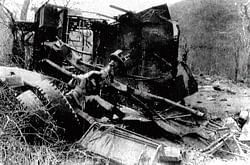
Palar landmine blast is considered the deadliest strike by sandalwood smuggler and forest brigand Veerappan’s gang, in police records, for claiming 22 lives and injuring 30 others.
After 21 years of the barbaric act, it’s in the news again as four of the bandit’s aides accused in the case - Simon, Gnanaprakasham, Meesekar Madaiah and Bilavendran - have moved the Supreme Court to commute their death sentence to life imprisonment.
The blast, masterminded by Veerappan, is an intriguing story. It all started with Veerappan daring the police to ‘catch me if you can’, after laying a death trap. On April 8, 1993, amid the hustle and bustle of a shandy at Kolathur near Mettur in Tamil Nadu, a poster in Tamil garners attention.
It was Veerappan inviting superintendent of police of the region, K Gopalakrishnan, popular as ‘Rambo’ Gopalakrishnan, to catch him saying, ‘I will be at Valanguli Patti tomorrow. If you are really born to your... catch me...’. It’s not just that, what had incited Rambo was Veerappan’s belligerent language.
The following day, April 9, 1993, Rambo Gopalakrishnan led a police team, besides local informers handpicked and nurtured by him and some forest personnel, on a Veerappan hunt. After reaching Palar bridge located between Mettur and Male Mahadeshwara Hills, the jeep carrying Gopalakrishnan and men develops a snag.
The Karnataka special task force deployed at the bridge, offer help to their TN counterparts. They hand over two buses of Karnataka State Reserve Police (KSRP) force. One bus carrying Gopalakrishnan, 15 informers, four police personnel and two forest watchers, all from Tamil Nadu, takes the lead. As an escort, another bus carrying Inspector M Ashok Kumar (also from TN)-led full-fledged police team follows.
Valanguli Patti is 12 km from Palar bridge and the buses carrying Gopalakrishnan and others had traversed around four km, when the vehicle in front explodes near Sorekai Madu. The time is around 12 noon.
A police personnel preferring anonymity told Deccan Herald, the bus carrying Ashok Kumar and police was still behind when the blast occurred. On reaching the blast site, they had to wait for the wall of dust to settle before they fired indiscriminately at the bushes and rocks.
Barring Gopalakrishnan, who survived the blast, the 22 men accompanying him were torn apart, with their bodies lying in pieces on trees and rocks. Gopalakrishnan, fully armed and standing on the footboard of his vehicle, was violently thrown out and he fell into a nearby ditch with severe injuries on his left leg, left hand and on his face.
The Police officer underwent nine surgeries and could return to duty only after one-and-a-half years!
The explosive material was gelatine sticks used for blasting rocks by illegal quarries in the region.
The sticks were stacked in 14 pits dug in equal number of days (one pit a day), nearly four to five feet deep and covered from the top. No sooner the bus carrying Gopalakrishnan and others arrived at the spot, Simon (accused in the case) triggers a dynamo-like device connected to the explosives through a wire drawn from the hills, causing the explosion.
According to the records, Veerappan had clearly instructed Simon to execute the blast only after the vehicle/s cross 10 pits, so that it will be a powerful blast. However, Simon triggers the blast soon after the bus crosses the first pit.
What had confused the master blaster, a former quarry worker whom Veerappan had engaged, was the bandit’s input that Gopalakrshnan and his men were coming in smaller vehicles (may be jeeps). When Simon sighted a bus, flummoxed, he set off the explosion. Simon too suffers injuries but bolts to safety.
The four “Veerappan gang” men, after the dust settled down that fateful day (who were later convicted in this case), had actually come “looking for him to see whether he was dead or alive” when Gopalakrishnan still lay writhing in pain in the ditch. That was how, he later said, he could identify the faces of the four accused in the ‘Trial Court’ in Mysore, on the basis of which they were convicted. The Supreme Court in its verdict also upheld Gopalakrishnan’s crucial testimony in this case as “reliable and trust worthy and that it can safely be made the basis of conviction.”
As per the documents cited in the Supreme Court judgment, of the 121 accused persons in the Palar bridge blast case, 50 persons were subsequently arrested and prosecuted. Of them, four were convicted.
Even Human rights activists now say that any commutation of the accused death sentence could only be from a larger humanitarian perspective, as the death penalty has been eschewed by many countries. The fact the four convicts have already spent nearly 20 years in jail is also a factor to reckon with, add human rights activists. The Supreme Court will now have the last word.
(With inputs from M R Venkatesh in Chennai.)
‘Rambo’ turns key to lock them in jail
A special court constituted to try Terrorist and Disruptive Activities (TADA) cases, was set up in Mysore (then undivided Mysore district with Chamarajanagar a part of it) and the
Agriculture Produce Marketing Committee training centre on Mysore- Hunsur road was converted into the court. The district and sessions judge presided over the TADA court too.
The final verdict came on September 29, 2001 with Judge D Krishnappa awarding life sentence to four accused in the Palar landmines blast case. The convicts later approached Supreme Court (as High Court was not entitled to hear TADA cases), which enhanced life sentence to death.
If not for Police officer Gopalakrishnan, a key witness who testified in the case and identified the convicted, there were chances of their acquittal as in other three cases - attack on Ramapura police station, Meenyam ambush that claimed the life of SP T Harikrishna and SI Shakeel Ahmed, and another attack on SP Gopal Hosur - due to lack of evidence.
Related Stories